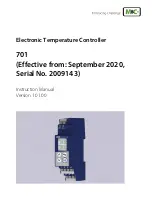
DRAWMER
18
the mono switch should be active but also either Left Cut or Right Cut should also
be activated (depending on preference/location) to derive the signal from a single
location.
Listen to the ‘Stereo difference’ or side signal
A very useful facility of the CMC3 is the ability to listen to the ‘stereo difference’ or
side signal, very quickly and easily. The side signal is the difference between the
two channels, and describes those elements that contribute to the stereo width.
Hearing the stereo difference is so simple using the CMC3: with the stereo signal
playing, activate the
Phase Reverse
switch, and then sum the left and right channels
using the
Mono
switch (in other words Left-Right). It’s that simple.
Being able to audition the ‘side’ signal is particularly useful for judging the quality
and quantity of any ambience or reverberation in a stereo mix. It is also an invaluable
facility if the stereo recording has timing differences between channels (such as
caused by an azimuth error on a tape machine), or for aligning a pair of desk
channels for use with X-Y stereo mic pairs. In both cases, listening for a deep
cancellation null, as the two signals cancel each other out, is a very fast and
accurate way of matching levels in each channel, which is the basis of accurate
alignment.
Active vs. Passive Circuits
There is a great debate as to which is best - a passive or active monitor control
circuit. The theory is that passive monitor controllers must be best, since they do
not add transformers or other components to the signal path, along with the
noise and distortion that they can bring, however they have severe disadvantages
over active circuits. The most significant is that the output impedance of the
connected source equipment and the input impedance of the power amp or
active speaker will affect the workings of the passive controller - each needs
buffering to remain reliable and consistent, otherwise level matching problems
will be inevitable. Since even the best cables have capacitance, it is extremely
important to keep cable lengths to an absolute minimum (i.e. less than a couple
of meters) to avoid signal degradation especially in high frequency signals.
Long cables will act like a simple low frequency filter.
Furthermore, it is incredibly difficult to get a mono signal from a passive circuit
without affecting the sound so any kind of reliable mix checking becomes near
impossible.
Active designs make it easier and more reliable to guarantee a high performance
level as the signal attenuation and switching is actively buffered, as well as
providing complete control over distortions, crosstalk, frequency response, and
transient fidelity. Moreover, cable lengths of tens of meters should not be an
issue. Furthermore, it makes it possible to introduce mix checking features that
would otherwise be missing. The disadvantage with active monitor controllers is
that the electronics have the potential to introduce noise and distortion. Designing
a clean monitor control system is far from simple, however, using only the very
best components and clever circuit design, with the Drawmer CMC3 we have
overcome all of these problems and managed to combine the best of both -
whilst retaining the transparency and responsiveness that a passive circuit would
bring with the advantages of an active one.
Содержание CMC3
Страница 9: ...CMC3 Monitor Controller TYPICAL CONNECTION GUIDE 9...
Страница 20: ...DRAWMER Ref 1v0A 28 06 18 BLOCK DIAGRAM 20...



































